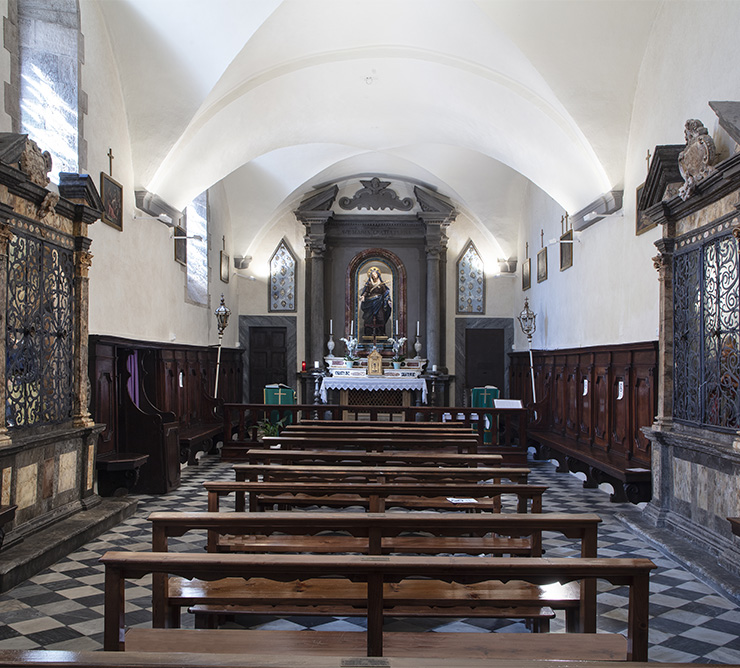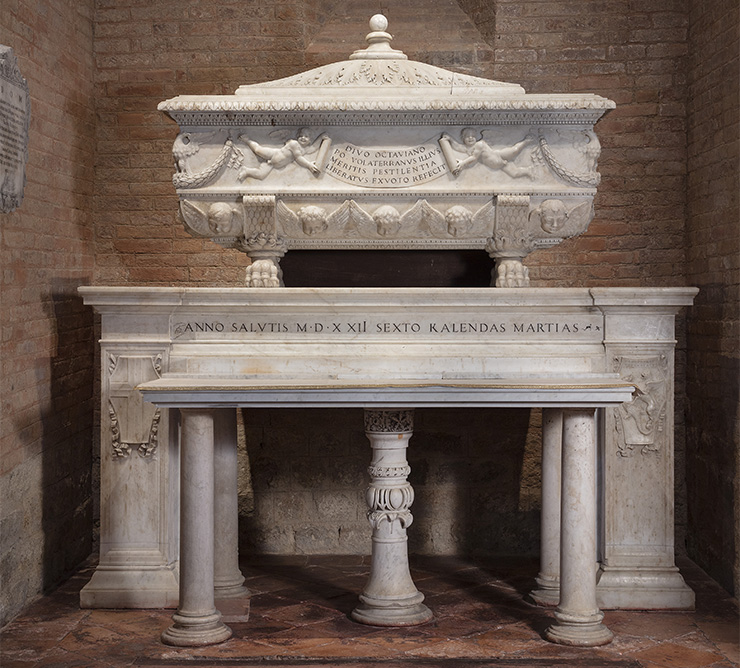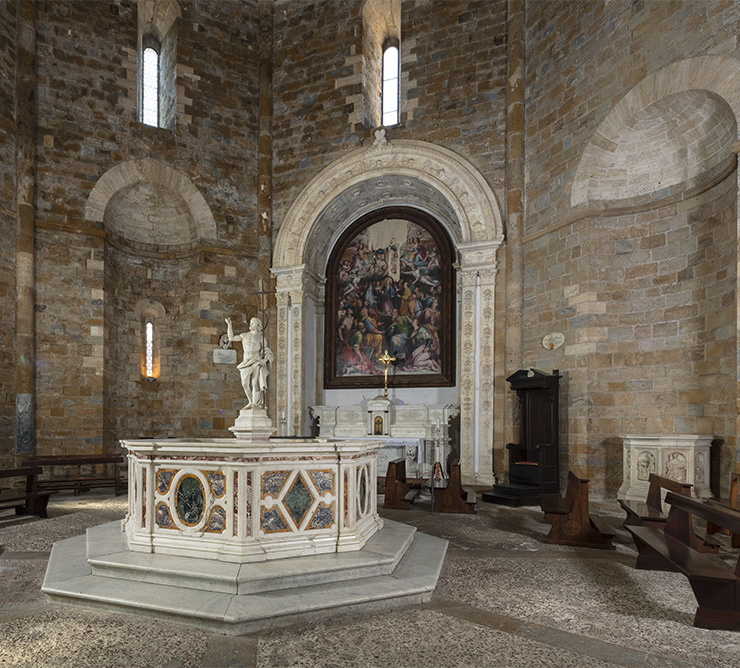The square represents the heart of Episcopal Volterra dating back to the last decades of the 5th century. The ancient town church, dedicated to Virgin Mary since the age of Charles the Great, was located where the Cathedral of Santa Maria Assunta is now located. The present Cathedral was consecrated on May 20th 1120 by Pope Callistus II as a result of a complex expansion of pre-existing religious buildings that started the urban redefinition of the episcopal area with the construction of the new Canons' Residence, the Bishop's Palace and the Baptistery, which was completed in 1283.
The ticket is valid for up to two days without time limits.
The artistic and spiritual itinerary starts at the Cathedral, the most significant and characterising monument of the community with its numerous masterpieces dating back to the early Middle Ages, as evidenced by the pulpit made before 1161. Among the oldest master... more
The artistic and spiritual itinerary starts at the Cathedral, the most significant and characterising monument of the community with its numerous masterpieces dating back to the early Middle Ages, as evidenced by the pulpit made before 1161. Among the oldest masterpieces is the imposing sculptural group of the Deposition, known in documents as Opus Crucifixi, dating back to 1228 and attributable to a craftsman active in Pisa in the first decades of the 13th century. It is one of the most important works of medieval wooden sculpture, both for its state of preservation and for the complexity of the group consisting of five figures with very intense expressions. The Cathedral, as already noted, is connected and intertwined with the other buildings in this urban area: San Giovanni, where the baptismal font, a masterpiece by Andrea Sansovino dating back to 1502, is kept, and the ancient Hospital of Santa Maria Maddalena, a religiously founded building committed to caring for the sick.
lessat the following times: 10:00 a.m. to 6:00 p.m.
(last entry at 5:30 p.m.)
Closed from 9 January to 28 February.
PLEASE NOTE: The Cathedral's opening hours may be subject to change during Religious Celebrations.
By train:
The quickest way to get to Volterra by train is to take the trains connecting the main Italian cities to Florence and from there continue by regional trains to Cecina or Pontedera, from where you can take a bus to Volterra. The Saline di Volterra railway station is also 10 km from the centre of Volterra, and is connected to Cecina by bus. More information on train schedules on the Trenitalia website.
By bus:
Public transport to Pisa, Pontedera and Volterra urban and extra-urban is operated by Compagnia Pisana Trasporti. More information on bus timetables for extra-urban routes to and from Volterra is available by calling the Call Centre 800.012.773. For connections to Siena and Florence, reach Colle Val d'Elsa with the CPT lines and then use the Sita Toscana services. Main lines: Line 500 Volterra / Pontedera (weekdays and holidays) - Line 501 Volterra / Pian dei Gelsi / Villamagna (weekdays) - Line 770 Volterra / Colle Val d'Elsa (weekdays and holidays) - Line 780 Volterra / Monterotondo (weekdays and holidays) - Line 790 Volterra / Saline FS / Cecina FS (weekdays) - Line 800 Volterra / Montecatini V.C. (weekdays).
By car:
You can reach Volterra by the following three main routes: from Cecina (40 km), from Colle Val d'Elsa (28 km) or from Pontedera (48 km). - from Milan (328 km) A1 motorway, in the direction of Bologna. To reach Parma, take the A15 motorway, in the direction of La Spezia. To reach the A12 motorway, in the direction of Livorno. Then join the SS1 road, direction Cecina. Exit at Cecina Nord and then follow the road SS68 / Via Volterrana - from Bologna (166 km) Highway A1, direction Florence. Exit at Firenze Impruneta, then follow the road in the direction of Siena. Exit Colle Val d'Elsa Nord and then follow the SS68 road to Volterra. - from Florence (70 km) Take the Firenze Siena motorway, exit at Colle Val d'Elsa Nord and then follow the SS68 road to Volterra. - from Rome (244 km) Highway A1, direction Florence. Exit at Firenze Impruneta and then follow the road towards Siena. Exit Colle Val d'Elsa Nord and then follow the SS68 road to Volterra.
By plane:
The nearest airports to Volterra are Pisa and Florence. Pisa Airport: The airport is directly connected to Pisa central station with departures every 30 minutes. The train station is right next to where the buses arrive. You can buy your ticket at the Information Office. Compagnia Pisana Trasporti CPT connects the airport and Pisa city centre every 20 minutes. The ticket costs € 0.80 and is valid for one hour on the whole urban area, you can buy it at the Information Office at the airport or at the end of the bus through the automatic machine. Florence Airport: It takes about 20 minutes to reach the city centre (Firenze S. M. Novella station) with the Ataf-Sita shuttle. Departures from the airport every 30 minutes from h. 6.00-20.30, every hour from h. 20.30-23.30. Departures from the centre every 30 minutes from h. 5.30-20.00, every hour from h. 20.00-23.00. Tickets can be purchased on the bus (€4.00 for one ride).

Inside the Cathedral, through the first door on the left aisle, one enters the Chapel of Our Lady of Sorrows or Oratory of the Virgin Mary, once the seat of the Confraternity of the same name, one of the oldest lay companies in the city. On the Chapel's two long walls are two niches housing polychrome terracotta sculptural groups depicting the Nativity and the Adoration of the Magi, referring to the work of Andrea Della Robbia, nephew of workshop founder Luca and active between the late 15th and early 16th century. In the niche on the left, which houses the Nativity, the background is a mural depicting the Procession of the Magi, the work of Benozzo Gozzoli who painted the same subject in the famous chapel of Palazzo Medici Riccardi in Florence in 1459.

In the right transept, in the first chapel next to the high altar, is the ark containing the body of St. Octavian. The tomb was executed in 1522 by Raphael Cioli da Settignano in thanksgiving for the end of a plague. St Octavian arrived from Christian Africa in the 6th century AD together with Saints Justus, Clement, Regulus and Cerbon. While Regulus and Cerbon stopped on the coast, Clement, Justus and Octavian continued on to Volterra, which they found besieged by the barbarians; Octavian retired to pray, while Justus and Clement made bread from the little flour left in the city and threw it over the walls into the enemy camp. The barbarians, amazed that there were still so many supplies in Volterra, lifted the siege. Octavian therefore retired to a hermit's life and spent the rest of his time fasting and praying in the hollow trunk of an elm tree near Volterra. After his death, a church dedicated to him was erected there, and in 820 the Bishop decided to transport the saint's body to the Cathedral.

The octagonal St. John's Baptistery has been documented since 1161. The facade, dated to the 13th century, is covered by a facing composed of bands of white and green marble in the Romanesque-Gothic style. The portal has a frieze decorated with a series of three-lobed arches containing small human heads depicting Christ, the Virgin Mary and all the Apostles, under which runs an inscription in hexameters referring to the execution of the portal in 1283. Inside, we can admire the panel painting by Niccolò Cercignani, known as Il Pomarancio, depicting the Ascension of Jesus into Heaven dated 1591 and the ancient marble baptismal font sculpted in 1502 by Andrea Sansovino. The current monumental font in the centre of the church is instead of 18th-century manufacture, executed in 1760 by Giovanni Vaccà and donated by Archbishop Francesco Salvatico dei Conti Guidi.